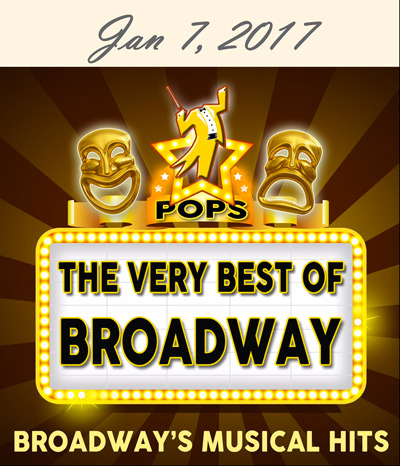[su_row]
[su_column size=”1/2″]
Concert 3 “The Very Best of Broadway”
January 7, 2017 at 7:30 PM
Wine & Cheese Reception 6:30 pm
Cailloux Theater – Kerrville, Texas
[/su_column]
[su_column size=”1/2″]
Evening’s Performances
Selections from
“Phantom of the Opera”
“A Chorus Line”
“My Fair Lady”
“Fiddler on the Roof”
“Cabaret”
“The Lion King”
To learn more about this concert, see the Conductor Letter and Program Notes below.
[/su_column]
[/su_row]
Conductor’s Letter
[su_row]
[su_column size=”1/2″]
Dear Symphony of the Hills Friends,
Broadway… That big city street name has become the iconic center of the musical theater universe with some forty theaters presenting the newest shows and reviving great standards. Well, start spreading the news, the Symphony of the Hills annual pop’s concert will bring to life the greatest tunes from some of Broadway’s most successful productions.
The Kathleen C. Cailloux Theatre will be illuminated with some of the brightest symphonic works from Broadway, including timeless standards such as Fiddler on the Roof, My Fair Lady, and Oklahoma, up through more recent shows such as Phantom of the Opera, The Lion King, and Wicked. [/su_column]
[su_column size=”1/2″]
The hill country community will get to hear the great collaborators including Lerner & Lowe and Rodgers & Hammerstein II, along with greats of music theater such as Andrew Lloyd Weber, Marvin Hamlisch, and even Hans Zimmer, whose The Lion King score was one of the few to jump from Hollywood to Broadway.
We think you’ll “feel the love tonight” through your presence in this wonderful program.
As always, thank you for your attendance and support,
Gene Dowdy
Conductor & Artistic Director
[/su_column]
[/su_row]
Program Notes
[su_row]
[su_column size=”1/2″]
According to theater aficionados (“the theater crowd”) as loosely defined in the New York Times, Broadway refers to theatrical performances presented in the 40 professional theatres with 500 or more seats located in the Theater District along Broadway, in Midtown Manhattan. Along with London’s West End theaters, Broadway theaters are widely considered to represent the highest level of commercial theater in the English-speaking world.
Although live theater has become prohibitively expensive for many, Broadway is a popular tourist attraction in New York City. No visit is deemed complete without at least one musical. The Broadway League (www.broadway.org,) states that in 2014 Broadway shows sold a record $1.36 billion worth of tickets, associated with audiences totaling over 13 million. Not surprisingly the trending of such attendance is a good indicator of the US economy.
Broadway musicals have become enormously influential forms of American popular culture, helping to make New York City the cultural capital of the nation. But it was not always so. Although New York City had theaters from about 1750, they were located “downtown,” and only began to proliferate in Times Square about 1900, the result of the lower cost of real estate in those venues.
Tonight’s repertoire represents the best of the best, featuring music that will be familiar to all:
Phantom of the Opera
Andrew Lloyd Weber (1948 – )
This musical opened in London’s West End in 1986 and on Broadway in 1988, with music by Andrew Lloyd Weber and lyrics by Charles Hart. Based on the French novel Le Fantôme de l’Opéra by Gaston Leroux, its central plot revolves around a beautiful soprano, Christine Daaé, who becomes the obsession of a mysterious, disfigured musical genius.
This musical won the 1986 Olivier Award and the 1988 Tony Award for Best Musical. Michael Crawford in the title role won the Olivier and Tony Awards for Best Actor in a Musical. It is the longest running show in Broadway history by a wide margin, and celebrated its 10,000th Broadway performance in 2012, the first production ever to do so.
A Chorus Line
Marvin Hamlisch (1944 – 2012)
With music written entirely by Marvin Hamlisch (who has appeared here in the Cailloux,) the show opened (with borrowed money) Off Broadway in 1975 but soon moved to the Broadway mainstream Schubert Theater, where it had the longest run on record until Cats beat that record in 1997.
The story centers on seventeen Broadway dancers who are auditioning for spots on a chorus line. It’s a simple story, set on the bare stage of a Broadway theatre during auditions, and provides a glimpse into the personalities of the performers as they describe events that shaped their lives. The music is captivating and inventive, with lyrics by Edward Kleban and choreography by Michael Bennett. The show was nominated for numerous awards, winning nine Tony Awards and the 1976 Pulitzer Prize for Drama, one of very few musicals ever to receive this honor.
My Fair Lady
Frederick Loewe (1901 – 1988)
My Fair Lady is a musical based on George Bernard Shaw’s Pygmalion, with book and lyrics by Alan Jay Lerner and music by Frederick Loewe. The story concerns Eliza Doolittle, a Cockney flower girl who takes speech lessons from Professor Henry Higgins, a phoneticist, so that she may pass as a lady. The original Broadway, London and film versions all starred Rex Harrison.
The musical’s 1956 Broadway production was an instant hit, setting a record at that time for the longest run of any major musical theatre production. It has been called “the perfect musical”.
[/su_column]
[su_column size=”1/2″]
Fiddler on the Roof
Jerry Bock (1928 – 2010)
Here is a musical that had a lot of people humming the songs following the show’s debut in 1964.
Winner of 9 Tony Awards when it debuted, Fiddler On The Roof is the brainchild of Broadway legends Jerome Robbins, Harold Prince, songwriters Jerry Bock, Sheldon Harnick, and writer Joseph Stein.
Set in the little village of Anatevka in early 20th century Russia, the story centers on Tevye, a poor Jewish milkman, who sees his five daughters married, each one moving further from traditional ways, and forcing him to cope with changing social mores and growing anti-Semitism of Czarist Russia. Rich in historical and ethnic detail, Fiddler’s universal theme of tradition is a staple of musical theatre, leaving audiences crying tears of laughter, joy and sadness.
Cabaret
John Kander (1927 -)
Cabaret is a musical based on a 1939 Christopher Isherwood book about Berlin, with music by John Kander. The 1966 Broadway production was a hit, and inspired a number of subsequent musical productions in London and New York, plus a 1972 film by the same name. Over several years and many score revisions, the show has received countless awards, having a timeless storyline and perpetually popular music.
Set in 1931 Berlin as the Nazis are rising to power, the show revolves around nightlife at the seedy Kit Kat Klub, and the relationship between teenaged English cabaret performer Sally Bowles and the young American writer Cliff Bradshaw.
A sub-plot involves the doomed romance between a German boarding house owner and her elderly suitor, a Jewish fruit vendor. Overseeing the action is the Master of Ceremonies at the Kit Kat Klub. The club serves as a metaphor for ominous political developments as Nazism overtakes Germany.
Cabaret has seen many revivals in many different venues. The story has remained pretty much the same over more than three decades but the music has changed repeatedly as has the emphasis on anti-Semitism and other prejudices embodied in Nazi Germany.
The Lion King
Elton John (1947 -)
The Lion King is an animated musical film released by Walt Disney Pictures, with original songs by Elton John and lyricist Tim Rice. The story takes place in a kingdom of lions in Africa, and holds many similarities with Shakespeare’s tragedy Hamlet; however, the adult content is changed and characters live “happily ever after” in the Disney interpretation.
In 1988, following their discussing an idea for a story set in Africa, Jeffrey Katzenberg and Roy Disney invited lyricist Tim Rice to write the songs as others were fleshing out the story. Rice accepted on the condition that he could find an appropriate composing partner. His first choice, Alan Menken, was unavailable and the producers accepted Rice’s suggestion of Elton John. John expressed an interest in writing “ultra-pop songs that kids would like; then adults can go and see those movies and get just as much pleasure out of them.” John mentioned the possible influence of The Jungle Book, where he felt the “music was so funny and appealed to kids and adults.” John scored on both points.
The Lion King was released in the summer of 1994, receiving an overwhelmingly enthusiastic reaction from movie-goers and critics. The movie was praised for its music, story and animation; it finished its run as the highest-grossing release of 1994. Following a 3D re-release in 2011, the film became the highest-grossing hand-drawn animated film in history. The Lion King garnered two Academy Awards for its achievement in music and the Golden Globe Award for Best Motion Picture – Musical or Comedy. The film has led to many works derived from the original story and score: a Broadway adaptation; the sequel The Lion King II; the prequel/parallel The Lion King 1½ (2004); and two television series.The music is infectious and some of the songs’ popularity has not waned in the 20+ years.
Concert Notes by Jim Adams
[/su_column]
[/su_row]




